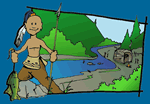


Geography and Landforms:
Vermont is nicknamed the Green Mountain State because of the Green Mountains that run through the middle of the state. Mount Mansfield is the tallest mountain in Vermont, at 4,235 feet. As mountain ranges go, the Green Mountains are very old, and have been sculpted to their present form during several ice ages. Granite, marble, slate asbestos and talc have all been mined from the range. Vermont's Lake Champlain is the sixth largest body of fresh water in the United States. Seventy-seven percent of Vermont is still forests.
|
 History:
The French explorer Samuel de Champlain sailed into the lake now named for him in 1609 with a party of Algonquin Indians. Their plan was to conquer lands in control of the Iroquois. Champlain called the area "Verde Mont," the French words for Green Mountains. The French did not attempt any permanent settlement until 1666, when they built a fort and a shrine to Saint Anne on the Isle La Motte in Lake Champlain. However, this and later French settlements were abandoned, and until well into the 18th century the region was something of a no-man's-land. The first permanent English settlement was established along the Connecticut River in 1724 at Fort Dummer, near what is now Brattleboro. The fort was maintained by the colonial governments of Massachusetts and New Hampshire as a defensive outpost throughout the French and Indian Wars.
Although Champlain had claimed the land for the country of France in 1763, the British took control of Vermont under the terms of the Treaty of Paris, the treaty that ended the French and Indian War. However, at that time, both the colonies of New York and New Hampshire claimed the land, then known as the "New Hampshire Grants," for themselves. Most of the European settlers were from Connecticut or Massachusetts, and did not wish to be under the control of New York. In 1775, Ethan Allen and his "Green Mountain Boys" organized in opposition to the "Yorkers," and in 1777 they declared Vermont an independent republic, which it remained until 1791 when Vermont became the 14th state admitted to the United States.
|
 Economy:
The rise of manufacturing in towns and villages during the early 19th century created a demand for produce for the non-farming population. Consequently, commercial farming began to crowd out the subsistence farming that had predominated since the mid-18th century. Grain and beef cattle became the chief market produce, but when the rapidly expanding West began to supply these commodities more cheaply and when wool textile mills began to spring up in Southern New England, Vermont turned to raising sheep.
|
 First Inhabitants:
Vermont's story begins with the native peoples who frequented the territory between the Connecticut River and Lake Champlain long before the Europeans came. Between 7,000 and 5,500 BC, we know that small groups of people lived throughout the lowlands of the Champlain Valley and along the Walloomsac River in southwestern Vermont. By around 4000 BC, the climate began to warm, and the number of people living in the area grew. The Natives were nomadic in most cases, however, and there were a few permanent settlements. Those without permanent villages returned to the same places year after year to raise corn or other crops. Evidence of woodworking tools seems to indicate that the people used dugout canoes for transportation along Vermont's rivers. By the materials used to make tools and other items, we know that the people traded with others. The Early Woodland period, beginning around 900 BC, brings the first evidence of pottery and bow and arrow.
|
Books Related To VermontCounting on Grace - Elizabeth Winthrop A Day No Pigs Would Die - Robert Newton Peck How Tia Lola Came to Stay - Julia Alvarez M is for Maple Syrup: A Vermont Alphabet - Cynthia Furlong Reynolds Reality Check - Peter Abrahams The Sweetness of Salt - Cecilia Galante Understood Betsy - Dorothy Canfield Fisher Where the Great Hawk Flies - Liza Ketchum Witness - Karen Hesse |
Famous Citizens:
|
| Capital: | Montpelier |
| Entered Union: | March 4, 1791 |
| Population: | 626,562 |
| Area | 9,614 |
| Bird | Hermit Thrush |
| Flower | Red Clover |
| Nickname: | Green Mountain State |
| Governor | Peter Shumlin |
Places to Visit in Vermont: (Click the links to learn more.)
|



